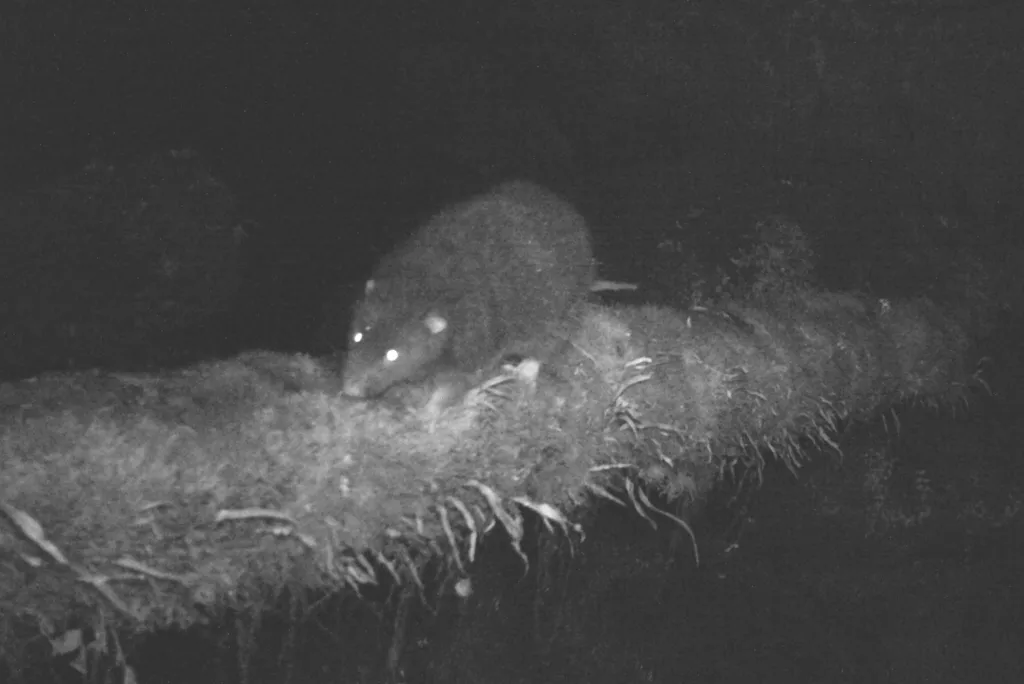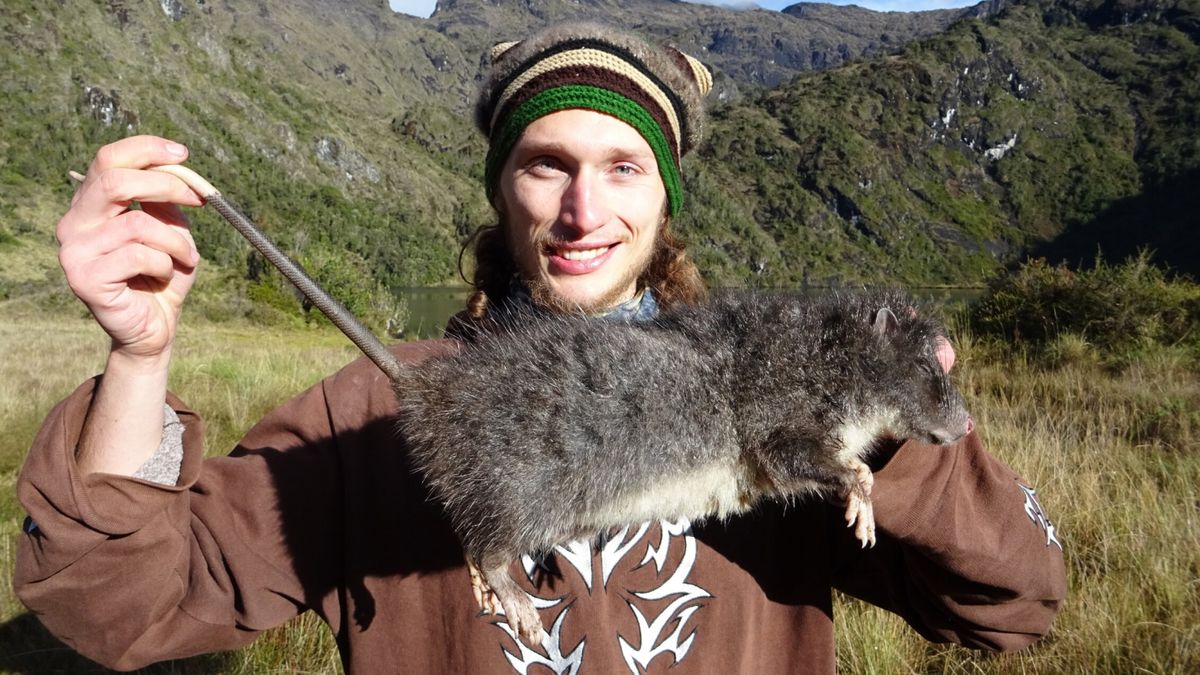See the First Photos and Videos of the Rare Subalpine Woolly Rat, a Massive but Elusive Rodent in New Guinea's Mountains
See the First Photos and Videos of the Rare Subalpine Woolly Rat, a Massive but Elusive Rodent in New Guinea’s Mountains
Working with local Indigenous people, biologist František Vejmělka spent six months surveying the creatures that live on Mount Wilhelm in Papua New Guinea
Trail cameras recorded nocturnal subalpine woolly rats roaming around in search of plants to eat.
Czech Academy of Sciences
The subalpine woolly rat lives high in the mountains of New Guinea, where it spends its nights searching for plants to eat and its days hiding in underground burrows or tree canopies. This furry rodent is massive, measuring more than 2.5 feet from nose to tail and tipping the scales at more than four pounds.
But despite its large size, the subalpine woolly ratis incredibly elusive. First described in 1989, the species was only known to scientists because of a few museum specimens, and it had never been photographed in the wild—until now.
František Vejmělka, a biologist at the Czech Academy of Sciences and the University of South Bohemia, spent six months exploring the highlands of Papua New Guinea. With help from local Indigenous people, he surveyed and genetically identified 61 species of rodents and marsupials found on Mount Wilhelm, a 14,793-foot peak and the country’s highest mountain. But perhaps his most significant work centered around the subalpine woolly rat.
Vejmělka captured the first photos and videos of the mysterious creature in the wild. He also caught a few individuals, which allowed him to take the first biometric measurements of males and gather data about the rats’ behavior, diet and parasites. He shared his findings in a paper published April 18 in the journal Mammalia.
By capturing several subalpine woolly rats, František Vejmělka was able to take the first biometric measurements of males of the species.
Czech Academy of Sciences
“It’s astonishing that such a large and striking animal has remained so poorly studied. How much more is there to discover about the biodiversity of tropical mountains?” Vejmělka says in a statement shared last week.
The subalpine woolly rat is the biggest rodent in Australia and Oceania, and it’s one of the largest in the world. It’s a “striking and formidable creature,” with three-inch-long paws, sharp teeth and dense, shaggy fur covering most of its body, according to the statement.
But these rodents are only active at night, and they live between 10,500 and 12,140 feet above sea level. Their rugged, remote habitats, coupled with their nocturnal habits, have made them difficult for researchers to study.
Subalpine Woolly Rat Filmed For The First Time
Watch on
Vejmělka was up for the challenge. He wanted to know more about this mysterious species, as well as the mammalian diversity of New Guinea more broadly. For help, he turned to several tribes living on Mount Wilhelm. Their support and collaboration were crucial to the project, he says.
The rats spend their days hiding in underground burrows or tree canopies, but they come out at night to search for food.
Czech Academy of Sciences
“If it weren’t for the Indigenous hunters who accompanied me in the mountains and helped me locate the animals, I would never have been able to collect this data,” he says in the statement.
From trail camera footage and biometric observations, Vejmělka was able to glean several new insights into the lives of these mysterious creatures. He learned they primarily eat ferns and other plant material, for example, and that both males and females have a reddish brown color on their chests, reports IFLScience’s Eleanor Higgs.
The species’ large size is likely due to “insular gigantism,” a biological phenomenon in which animals on islands evolve to become larger than those on the mainland, Vejmělka tells Live Science’s Jess Thomson in an email.
Scientists think the rodents’ predecessors first arrived on New Guinea roughly five million years ago. Without much competition to worry about, they’ve been able to adapt to the rainforest landscape and thrive.
“Their ancestors arrived from Asia to the island completely absent of any other terrestrial placental mammals,” Vejmělka adds to Live Science.
Get the latest stories in your inbox every weekday.
#see #first #photos #videos #rare
See the First Photos and Videos of the Rare Subalpine Woolly Rat, a Massive but Elusive Rodent in New Guinea's Mountains
See the First Photos and Videos of the Rare Subalpine Woolly Rat, a Massive but Elusive Rodent in New Guinea’s Mountains
Working with local Indigenous people, biologist František Vejmělka spent six months surveying the creatures that live on Mount Wilhelm in Papua New Guinea
Trail cameras recorded nocturnal subalpine woolly rats roaming around in search of plants to eat.
Czech Academy of Sciences
The subalpine woolly rat lives high in the mountains of New Guinea, where it spends its nights searching for plants to eat and its days hiding in underground burrows or tree canopies. This furry rodent is massive, measuring more than 2.5 feet from nose to tail and tipping the scales at more than four pounds.
But despite its large size, the subalpine woolly ratis incredibly elusive. First described in 1989, the species was only known to scientists because of a few museum specimens, and it had never been photographed in the wild—until now.
František Vejmělka, a biologist at the Czech Academy of Sciences and the University of South Bohemia, spent six months exploring the highlands of Papua New Guinea. With help from local Indigenous people, he surveyed and genetically identified 61 species of rodents and marsupials found on Mount Wilhelm, a 14,793-foot peak and the country’s highest mountain. But perhaps his most significant work centered around the subalpine woolly rat.
Vejmělka captured the first photos and videos of the mysterious creature in the wild. He also caught a few individuals, which allowed him to take the first biometric measurements of males and gather data about the rats’ behavior, diet and parasites. He shared his findings in a paper published April 18 in the journal Mammalia.
By capturing several subalpine woolly rats, František Vejmělka was able to take the first biometric measurements of males of the species.
Czech Academy of Sciences
“It’s astonishing that such a large and striking animal has remained so poorly studied. How much more is there to discover about the biodiversity of tropical mountains?” Vejmělka says in a statement shared last week.
The subalpine woolly rat is the biggest rodent in Australia and Oceania, and it’s one of the largest in the world. It’s a “striking and formidable creature,” with three-inch-long paws, sharp teeth and dense, shaggy fur covering most of its body, according to the statement.
But these rodents are only active at night, and they live between 10,500 and 12,140 feet above sea level. Their rugged, remote habitats, coupled with their nocturnal habits, have made them difficult for researchers to study.
Subalpine Woolly Rat Filmed For The First Time
Watch on
Vejmělka was up for the challenge. He wanted to know more about this mysterious species, as well as the mammalian diversity of New Guinea more broadly. For help, he turned to several tribes living on Mount Wilhelm. Their support and collaboration were crucial to the project, he says.
The rats spend their days hiding in underground burrows or tree canopies, but they come out at night to search for food.
Czech Academy of Sciences
“If it weren’t for the Indigenous hunters who accompanied me in the mountains and helped me locate the animals, I would never have been able to collect this data,” he says in the statement.
From trail camera footage and biometric observations, Vejmělka was able to glean several new insights into the lives of these mysterious creatures. He learned they primarily eat ferns and other plant material, for example, and that both males and females have a reddish brown color on their chests, reports IFLScience’s Eleanor Higgs.
The species’ large size is likely due to “insular gigantism,” a biological phenomenon in which animals on islands evolve to become larger than those on the mainland, Vejmělka tells Live Science’s Jess Thomson in an email.
Scientists think the rodents’ predecessors first arrived on New Guinea roughly five million years ago. Without much competition to worry about, they’ve been able to adapt to the rainforest landscape and thrive.
“Their ancestors arrived from Asia to the island completely absent of any other terrestrial placental mammals,” Vejmělka adds to Live Science.
Get the latest stories in your inbox every weekday.
#see #first #photos #videos #rare
·41 Просмотры




